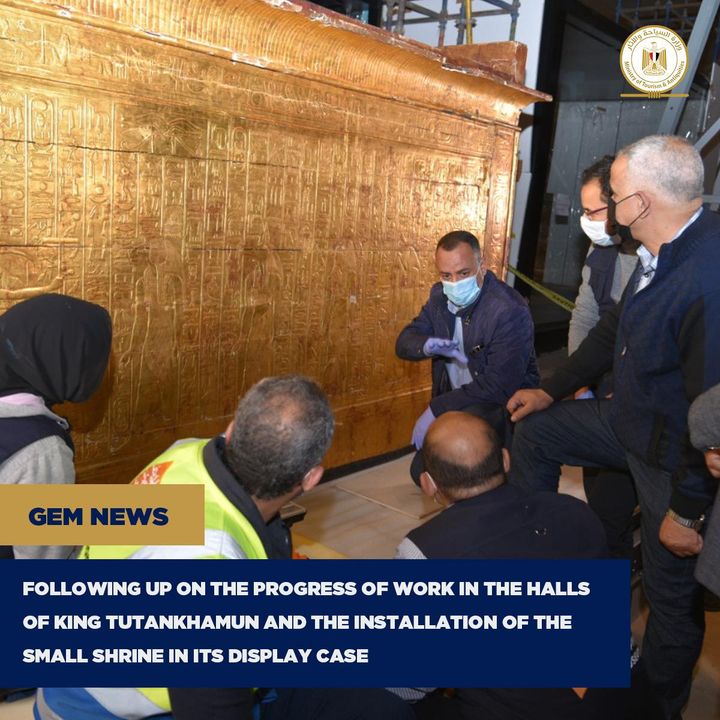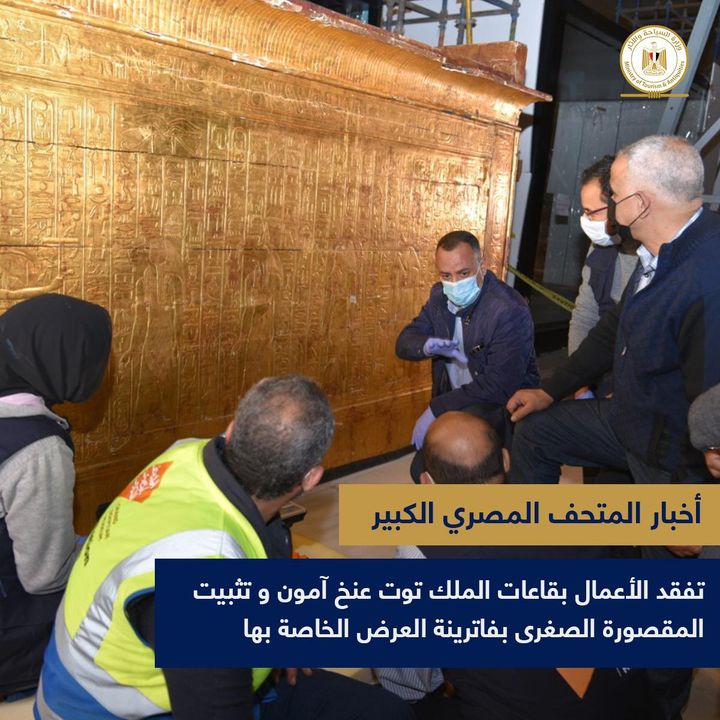تفقد اليوم الدكتور مصطفى وزيري الأمين العام للمجلس الأعلى للآثار، والدكتور الطيب عباس مساعد وزير السياحة والآثار للشئون الأثرية بالمتحف المصري الكبير، أعمال تجهيز قاعات العرض الخاصة بكنوز الملك توت عنخ آمون ووضع القطع الأثرية داخل الفتارين الخاصة بها وفقا لسيناريو العرض المتحفي المقرر مسبقا.
كما تفقدا أعمال ترميم وتثبيت المقصورة الصغرى للملك توت عنخ آمون داخل الفاترينة الخاصة بها والتي استقبلها المتحف المصري الكبير خلال الشهر الجاري من المتحف المصري بالتحرير، حيث شهدا أعمال تنظيف المقصورة وتقوية الأماكن الضعيفة منها.
وأوضح الدكتور مصطفي وزيري أن عملية تجميع المقصورة الصغرى فقط داخل فاترينة عرضها استغرق ما يزيد عن عشر ساعات من العمل المتواصل؛ حيث اتبع المرممين والأثريين بالمتحف المصري الكبير نفس طريقة وتكنيك الصناعة الذي اتبعه المصري القديم من حيث الفك إلى أجزاء قبل نقلها وتركيبها بنفس الطريقة داخل القاعة بالمتحف المصري الكبير.
وأضاف أنه حتى الآن تم الإنتهاء من وضع ٥١ فاترنية داخل قاعات الملك توت عنخ آمون كما تم تثبيت عدد من تماثيل الأوشابتي والصناديق الخشبية وثلاثة أسرة جنائزية للملك داخل الفتارين الخاصة بها.
وأكد الدكتور حسين كمال مدير مركز الترميم، على أنه تم استخدام مواد خالية من الحموضة أثناء عملية ترميم المقصورة الصغرى كما تم اتخاذ كافة الإجراءات العلمية اللازمة لتقوية وصيانة الأجزاء الضعيفة منها بما يضمن سلامة المقصورة داخل فاترينة العرض.
وأشار إلى أن المقصورة الصغرى تتميز بسقف مقبي وتظهر على جوانبها مناظر للمعبودات، والمرتبطة بإعادة ميلاد الملك وبعثه في العالم الآخر بالإضافة إلى الفصل ١٧ من كتاب الموتى.
وأوضح الدكتور عيسى زيدان مدير عام الشئون التنفيذية للترميم ونقل الآثار بالمتحف المصري الكبير، أنه لعرض هذه المقصورة وغيرها من مقاصير الملك الشاب تم تصميم فتارين عرض خاصة لهم بديناميكية عالية بحيث يتم سحب أرضية الفاترينة كاملة خارج الإطار الزجاجي لها لتُثبت عليها المقصورة ويتم ادخالها كاملة بعد ذلك لداخل الفاترينه، مشيرا إلى أن هذه المقصورة واحدة من أربعة مقاصير للملك الذهبي والتي سوف يتم نقلهم تباعاً لتعرض جميعها بمقرهم الجديد بالمتحف المصري الكبير وفقاً لأحدث طرق العرض المتحفي.
جدير بالذكر أن هذه المقصورة تم العثور عليها مفككة ضمن مقتنيات الملك بمقبرته بالبر الغربي بالأقصر والتي تم الكشف عنها فى نوفمبر ١٩٢٢، ثم تم نقلها مع باقي القطع إلى المتحف المصري بالتحرير حيث تم تجميعها وعرضها.
وعلى الرغم من أن هذه المقصورة تعتبر هي أصغر مقاصير الملك توت عنخ آمون إلا أنها تعتبر من أكبر القطع الأثرية التي تم نقلها من كنوز الملك حتى الآن إلى المتحف.
Following up on the progress of work in the halls of King Tutankhamun
Dr. Mostafa Waziry, Secretary-General of the Supreme Council of Antiquities, and Dr. Al-Tayeb Abbas, Assistant Minister of Tourism and Antiquities for Archaeological Affairs at the Grand Egyptian Museum, followed up on the progress of work in the exhibition halls of the treasures of King Tutankhamun and placing the artifacts inside their display cases according to the set museum display scenario.
They also followed up on the restoration and installation work of the small shrine of King Tutankhamun inside its display case. The Grand Egyptian Museum received this shrine last month from the Egyptian Museum in Tahrir.
Dr. Mostafa Waziry explained that the process of assembling the small shrine inside its show case took more than ten hours of continuous work. Where restorers and archaeologists in the Grand Egyptian Museum followed the same method and technique of industry that the ancient Egyptians followed in terms of jawing into parts before transporting and installing them in the same way inside its hall in the Grand Egyptian Museum.
He added that up till now, 51 vases have been placed inside the halls of King Tutankhamun, and a number of shabti statues, wooden boxes and three funeral beds for the king have been installed inside their own cases.
Dr. Hussein Kamal, Director of the Restoration Center, confirmed that acid-free materials were used during the restoration process of the small shrine, and all scientific measures necessary to strengthen and maintain the weak parts of it were taken to ensure the safety of the shrine inside the showroom.
He pointed out that the small shrine is distinguished by a vaulted ceiling, and on its sides there are scenes of deities associated with the re-birth of the king and his resurrection in the afterlife, in addition to chapter 17 of the Book of the Dead.
Dr. Issa Zidan, Director General of the Executive Affairs for Restoration and Transfer of Antiquities at the Grand Egyptian Museum, explained that to display this shrine and other of the young king’s booths, two special showcases were designed for them with high dynamism so that the whole floor of the shrine is pulled out of its glass frame to fix it and is inserted completely. He pointed out that this cabin is one of the four compartments of the golden king, which will be transferred in succession, and all of them will be displayed in their new headquarters in the Grand Egyptian Museum, according to the latest museum display methods.
It is worth noting that this cabin was found disassembled among the king’s holdings in his tomb on the western mainland in Luxor, which was discovered in November 1922, and then it was then transferred with the rest of the pieces to the Egyptian Museum in Tahrir, where they were collected and displayed.
Although this shrine is considered the smallest of King Tutankhamun’s tomb, it is considered one of the largest artifacts that have been transferred from the king’s treasures so far to the GEM.
Ministry of Tourism and Antiquities وزارة السياحة والآثار



